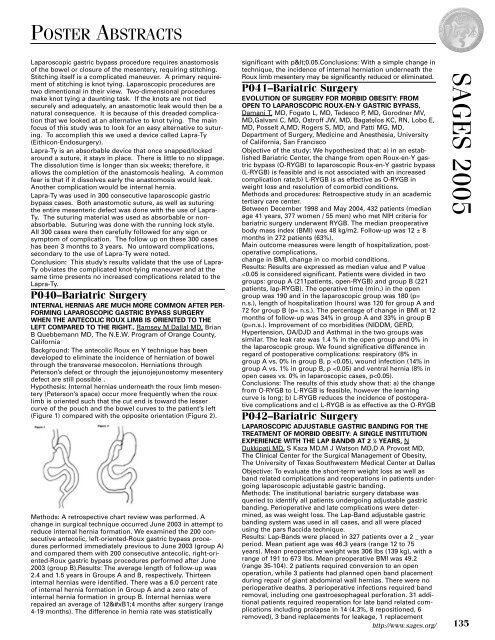2005 SAGES Abstracts
2005 SAGES Abstracts
2005 SAGES Abstracts
Create successful ePaper yourself
Turn your PDF publications into a flip-book with our unique Google optimized e-Paper software.
POSTER ABSTRACTS<br />
Laparoscopic gastric bypass procedure requires anastomosis<br />
of the bowel or closure of the mesentery, requiring stitching.<br />
Stitching itself is a complicated maneuver. A primary requirement<br />
of stitching is knot tying. Laparoscopic procedures are<br />
two dimentional in their view. Two-dimensional procedures<br />
make knot tying a daunting task. If the knots are not tied<br />
securely and adequately, an anastomotic leak would then be a<br />
natural consequence. It is because of this dreaded complication<br />
that we looked at an alternative to knot tying. The main<br />
focus of this study was to look for an easy alternative to suturing.<br />
To accomplish this we used a device called Lapra-Ty<br />
(Eithicon-Endosurgery).<br />
Lapra-Ty is an absorbable device that once snapped/locked<br />
around a suture, it stays in place. There is little to no slippage.<br />
The dissolution time is longer than six weeks; therefore, it<br />
allows the completion of the anastomosis healing. A common<br />
fear is that if it dissolves early the anastomosis would leak.<br />
Another complication would be internal hernia.<br />
Lapra-Ty was used in 300 consecutive laparoscopic gastric<br />
bypass cases. Both anastomotic suture, as well as suturing<br />
the entire mesenteric defect was done with the use of Lapra-<br />
Ty. The suturing material was used as absorbable or nonabsorbable.<br />
Suturing was done with the running lock style.<br />
All 300 cases were then carefully followed for any sign or<br />
symptom of complication. The follow up on these 300 cases<br />
has been 3 months to 3 years. No untoward complications,<br />
secondary to the use of Lapra-Ty were noted.<br />
Conclusion: This study’s results validate that the use of Lapra-<br />
Ty obviates the complicated knot-tying maneuver and at the<br />
same time presents no increased complications related to the<br />
Lapra-Ty.<br />
P040–Bariatric Surgery<br />
INTERNAL HERNIAS ARE MUCH MORE COMMON AFTER PER-<br />
FORMING LAPAROSCOPIC GASTRIC BYPASS SURGERY<br />
WHEN THE ANTECOLIC ROUX LIMB IS ORIENTED TO THE<br />
LEFT COMPARED TO THE RIGHT., Ramsey M Dallal MD, Brian<br />
B Quebbemann MD, The N.E.W. Program of Orange County,<br />
California<br />
Background: The antecolic Roux en Y technique has been<br />
developed to eliminate the incidence of herniation of bowel<br />
through the transverse mesocolon. Herniations through<br />
Peterson’s defect or through the jejunojejunostomy mesentery<br />
defect are still possible .<br />
Hypothesis: Internal hernias underneath the roux limb mesentery<br />
(Peterson’s space) occur more frequently when the roux<br />
limb is oriented such that the cut end is toward the lesser<br />
curve of the pouch and the bowel curves to the patient’s left<br />
(Figure 1) compared with the opposite orientation (Figure 2).<br />
Methods: A retrospective chart review was performed. A<br />
change in surgical technique occurred June 2003 in attempt to<br />
reduce internal hernia formation. We examined the 200 consecutive<br />
antecolic, left-oriented-Roux gastric bypass procedures<br />
performed immediately previous to June 2003 (group A)<br />
and compared them with 200 consecutive antecolic, right-oriented-Roux<br />
gastric bypass procedures performed after June<br />
2003 (group B).Results: The average length of follow-up was<br />
2.4 and 1.5 years in Groups A and B, respectively. Thirteen<br />
internal hernias were identified. There was a 6.0 percent rate<br />
of internal hernia formation in Group A and a zero rate of<br />
internal hernia formation in group B. Internal hernias were<br />
repaired an average of 12±4 months after surgery (range<br />
4-19 months). The difference in hernia rate was statistically<br />
significant with p<0.05.Conclusions: With a simple change in<br />
technique, the incidence of internal herniation underneath the<br />
Roux limb mesentery may be significantly reduced or eliminated.<br />
P041–Bariatric Surgery<br />
EVOLUTION OF SURGERY FOR MORBID OBESITY: FROM<br />
OPEN TO LAPAROSCOPIC ROUX-EN-Y GASTRIC BYPASS,<br />
Damani T, MD, Fogato L, MD, Tedesco P, MD, Gorodner MV,<br />
MD,Galvani C, MD, Ostroff JW, MD, Bagatelos KC, RN, Lobo E,<br />
MD, Posselt A,MD, Rogers S, MD, and Patti MG, MD,<br />
Department of Surgery, Medicine and Anesthesia, University<br />
of California, San Francisco<br />
Objective of the study: We hypothesized that: a) in an established<br />
Bariatric Center, the change from open Roux-en-Y gastric<br />
bypass (O-RYGB) to laparoscopic Roux-en-Y gastric bypass<br />
(L-RYGB) is feasible and is not associated with an increased<br />
complication rate;b) L-RYGB is as effective as O-RYGB in<br />
weight loss and resolution of comorbid conditions.<br />
Methods and procedures: Retrospective study in an academic<br />
tertiary care center.<br />
Between December 1998 and May 2004, 432 patients (median<br />
age 41 years, 377 women / 55 men) who met NIH criteria for<br />
bariatric surgery underwent RYGB. The median preoperative<br />
body mass index (BMI) was 48 kg/m2. Follow-up was 12 ± 8<br />
months in 272 patients (63%).<br />
Main outcome measures were length of hospitalization, postoperative<br />
complications,<br />
change in BMI, change in co morbid conditions.<br />
Results: Results are expressed as median value and P value<br />
















